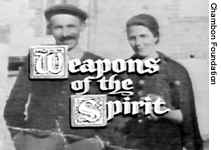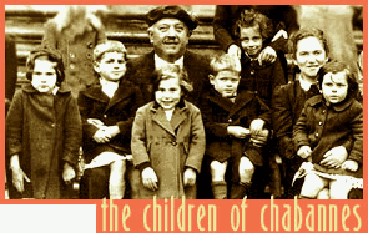 No doubt, some will feel that I am
being petty and self-serving in raising these issues--given the genuine qualities of your
film--and
indeed I have long hesitated about doing so.
No doubt, some will feel that I am
being petty and self-serving in raising these issues--given the genuine qualities of your
film--and
indeed I have long hesitated about doing so.[Varian Fry Institute] [Chambon Foundation Home] [Chambon Institute Home]
Chabannes & Le Chambon
Open
Letter from Pierre Sauvage to Lisa Gossels,
producer of the 2000 documentary The Children of
Chabannes
 Comments
by the filmmakers of The Children of Chabannes about their own documentary (from their website): "A tale of courage, resilience and love set during WWII,
The Children of Chabannes tells the story of how the people of Chabannes,
a tiny village in unoccupied France, chose action over indifference and saved
the lives of 400 Jewish refugee children. . . .Through accounts
by the extraordinary teachers who taught and loved these children, this lyrical
and moving film shows the remarkable efforts made by the citizens of Chabannes,
who risked their lives and livelihoods to protect these children, simply because
they felt it was the right thing to do."
Comments
by the filmmakers of The Children of Chabannes about their own documentary (from their website): "A tale of courage, resilience and love set during WWII,
The Children of Chabannes tells the story of how the people of Chabannes,
a tiny village in unoccupied France, chose action over indifference and saved
the lives of 400 Jewish refugee children. . . .Through accounts
by the extraordinary teachers who taught and loved these children, this lyrical
and moving film shows the remarkable efforts made by the citizens of Chabannes,
who risked their lives and livelihoods to protect these children, simply because
they felt it was the right thing to do."
Dear Lisa:
As you know, I found your and Dean Wetherell's documentary The Children of Chabannes to be a remarkable gallery of remarkable people. How fortunate it is that the good die old. What a delight it is to be reminded that there were Jewish rescuers too! How important it is to recognize the O. S. E.'s efforts--a Jewish organization that made the right choices then--and the devoted people who rose to the occasion.
Thanks to you, I will never forget Félix Chevrier, Irène and Renée Paillassou, Georges Loinger, Rachel Pludermacher... Congratulations also for effectively and unflinchingly including the horror.
But your film claims to be more than the wonderful story of an O. S. E. children’s home run by some dedicated people, and of some of the children who were sheltered there. You want audiences to believe that your film is about a village that "chose action over indifference" and "saved the lives of 400 Jewish refugee children." Yet it does not appear that this is what happened in Chabannes.
To begin with, I understand that there were about fifty people who then lived near the old château de Chabannes, where there had once been a village. Perhaps this still constituted a village. But with so few people involved, it shouldn't have been difficult to identify the villagers.
Why are the Paillassou sisters the only local residents identified as having participated in the rescue effort? Why is nobody else (besides the Paillassou's father) spoken about or even shown in photographs?
How can you tell the story of a village and barely refer to any of the villagers?
And as for the village itself, you do show one several times that looks like any other small French village. I am sure I was not alone in assuming that this was Chabannes, since you never indicate otherwise. But is it not, in fact, the nearby village of St. Pierre de Fursac (which with its twin village of St. Etienne is known as Fursac)? What's going on here?
And is it not true that historians indicate that 140 Jewish children found shelter at the château de Chabannes--not the 400 children to which you refer? Four hundred appears to be the number of children sheltered throughout the especially hospitable Creuse area of France, where the château de Chabannes and Fursac are located. Why blur the distinction between the Creuse and Chabannes?
Furthermore, when the children's home at Chabannes was disbanded in 1943, you don't indicate that the villagers took in any of the Jewish children, at a time of greatest risk for these children. No doubt, the O. S. E. may have deemed it safer to place the children elsewhere--you skip over that part of the story--but this was hardly the persistent village effort you claim.
Yes, Félix Chevrier upon his arrival in the area in 1939 was assisted notably by the dedicated local teachers Irène Paillassou and Renée Paillassou (I was very sorry to learn that the latter has recently died). It is entirely fitting that Chevrier and the Paillassou sisters have been recognized as Righteous Among the Nations by Israel's Holocaust memorial Yad Vashem. But are not Irène and Renée Paillassou, in fact, the only villagers from the area to receive Yad Vashem recognition? If so, why?
Not to be coy about it, your characterization of your documentary evokes another well known and documented story of collective rescue in France, the story of the area of Le Chambon-sur-Lignon which was collectively honored by Yad Vashem for the rescue effort that took place there throughout the war and was the subject of my own 1989 documentary Weapons of the Spirit.
You asked to see the documentary when you embarked on your own film. Compounding the confusion between our films is the coincidence of the similar names and the fact that Le Chambon became, as I put it in the documentary, "a village of children."
Incidentally, all this is not to say that there weren't other French villages where efforts similar to what went on in the area of Le Chambon occurred (although not quite on the scale of what happened in Le Chambon, the most densely Protestant area of France, blessed then with inspired leadership). There is, for instance, the still largely unchronicled story of the village of Dieulefit.
Because French peasants in general acted better than city people--I believe they had a greater sense of what was natural, and what was happening to the Jews was not natural--I don't doubt that throughout rural areas of France, Jews in hiding experienced more goodwill than elsewhere. This was certainly true for my parents and me, as I'm sure it was true for your father and your uncle in the area of Fursac.
There is certainly compelling evidence that Jews fared better in the very rural department of the Creuse, where your story is set, than in most other places in France. As is omitted from your film, the O. S. E. in fact ran two other children's homes in the Creuse department, not far from Chabannes: at the château de Chaumont and at the château Le Masgelier.
Indeed, much of the testimony in your film that appears to be about Chabannes is in fact about the population of the Creuse department in general. This is true in particular for historian Serge Klarsfeld--who as a child found shelter at Le Masgelier--as well for the other historians you interviewed. Do they specifically back your claims for the village of Chabannes?
In Weapons of the Spirit, I refer to the "conspiracy of goodness" that I believe occurred in Le Chambon. What happened at Chabannes appears to me to have been very different--and not merely because the strong religious component in Le Chambon was not present in the Creuse,
But whatever the actual numbers and whatever the differences with the story of Le Chambon, please believe that I agree with you that something important happened at Chabannes too: dedicated educators, under the leadership of the vividly portrayed Félix Chevrier and under the auspices of the Jewish O. S. E. organization, committed themselves to the welfare and survival of Jewish children during the war.
Your background is in advertising. In that world, the objective of a new product is often to replace an earlier one, and considerable effort is expended on packaging and marketing the product, often with little regard for what the product actually is.
 No doubt, some will feel that I am
being petty and self-serving in raising these issues--given the genuine qualities of your
film--and
indeed I have long hesitated about doing so.
No doubt, some will feel that I am
being petty and self-serving in raising these issues--given the genuine qualities of your
film--and
indeed I have long hesitated about doing so.
But Chabannes was Chabannes and Le Chambon was Le Chambon. Those who still remember Weapons of the Spirit and will see The Children of Chabannes will no doubt agree that the differences between both stories are worth preserving, and that there is room for both documentary accounts of what was possible during an especially challenging time in history.
For information—in French—on rescue at the château de
Chabannes
and in the Creuse department, see the very useful website of the Cité
scolaire Raymond Loewy. See also The
Children of Chabannes documentary website, Le
Chambon-sur-Lignon, and Weapons
of the Spirit..
See also O. S. E.
Review by Kevin
Thomas, Los Angeles Times
[Varian Fry Institute] [Chambon Foundation Home] [Chambon Institute Home]
[email us] [contact information] [table of contents] [search] [feedback] [guest book] [link to us?]
© Copyright 2000, Chambon Foundation. All rights reserved. Revised: May 20, 2010